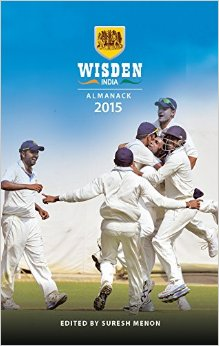Wisden India 2015
Martin Chandler |Published: 2015
Pages: 859
Author: Menon, Suresh (Editor)
Publisher: Bloomsbury
Rating: 3.5 stars

Throughout my childhood the only time I saw Wisden’s saffron covers in the shops was every April as the new season beckoned. Later, from June 1979, the iconic Ravilious woodcut appeared, as a very modest logo, on a monthly basis, as Wisden Cricket Monthly was born. In recent years however Wisden has become a brand. An Australian edition that ran from 1998 – 2006 failed, but since Bloomsbury acquired the Almanack back in 2008 we seem to have had Wisden on just about everything and, of course, always with those saffron dust jackets.
Since 2013 there has also been a new kid on the block. A book bound in blue cloth with a predominately blue jacket has appeared from India. Modelling itself on the venerable original what I will call the Third Best Exotic Wisden Almanack is a curious addition to my library. To steal the soubriquet from the Marigold Hotel films is intended as a compliment, albeit one some might feel is slightly back-handed. I make the comparison because the Indian Wisden, like the famous hotel, is a little chaotic, slightly shabby in places but, at the end of the day, it has a truly authentic Indian feel to it, and is a source of rich entertainment.
Parts of the book are very much like the northern hemisphere model. The book reviews and obituaries, two of my favourite parts of the Almanack, follow the same style with an Indian bias. Both are excellent. The records section on the other hand is not remotely similar. I dare say its contents are almost exclusively Test match related. I would accept that the average Indian reader is not going to be desperately interested in records founded on the English First Class game, but I for one cannot see myself ever consulting the records section of Wisden India.
Part 3 of the book contains 156 pages on Indian domestic cricket and a myriad of tournaments, and almost 30 of those pages are about the IPL. I don’t fully appreciate the subtleties, if there are any, of the structure of Indian cricket, and this is the section I have in mind most when I use the word chaotic. The way the scores are set out here is a large part of the reason for that. Scorecards in the standard Wisden style are few and far between, and when they are encountered they look a little unusual. I have no complaints about the appearance of economy rates and scoring rates, although if the former are to be included for Tests I struggle with what the rationale might be for excluding the latter. That factor apart the cards still don’t look quite right, but perhaps the decision to set them out slightly differently was taken solely to be distinctive from the traditional Wisden approach.
There is some coverage of overseas cricket, and a good deal about the women’s game. Nigh on thirty pages on the latter subject and a mere page and a half on the English season did bring a smile to my face. I don’t mind that at all, after all I don’t buy my yellow Wisden to read about the Indian summer, but I do like to see full scorecards for all Test matches played anywhere in the world, and whilst Wisden India does have a full commentary on, for example, the 2013/2014 Ashes, surely anyone taking the time to read that is going to want a little more than a few lines of potted scores?
In days of old Wisden began with the authoritative notes by its editor, followed by essays on the Five Cricketers of the Year and then just a few articles before launching into the statistics and reportage of the main course. That has changed now and the part of the book that contains the “narrative” content is much more important than ever it used to be, and Wisden India is right up to the mark on that one. Suresh Menon’s notes are just as they should be – insightful and trenchant. The essays on Wisden India’s Six Cricketers of the Year – Ajinkya Rahane, Mithali Raj, Rishi Dhawan, Umar Akmal, Angelo Mathews and Mominul Haque – are superb. This is one area that, as an Englishman who has heard of these men but not necessarily seen a great deal of them, I particularly enjoyed.
There is a delightful nod back to history as well. On only its third edition Wisden India does not have much in the way of a tradition of its own yet, so it has gone back into the past to find something. In his preface Menon makes mention of an article written by Jack Hobbs in the short-lived Crickinia annual in 1939 that called for an Indian Wisden, and later on the article is reproduced in full. It is delightful period prose, and one of only a few pieces of writing by Englishmen in the book. Most of the twenty or so essays are topical, but there is also some unabashed nostalgia in some excellent writing about Bishan Bedi and Vijay Hazare.
So finally I come to the tricky task of attributing a rating to Wisden India 2015. Given not insignificant parts of the book go, to all intents and purposes over my head, and that others do not appeal greatly I am going to give 3.5 stars, but that is with an English audience in mind. For the locals I would be happy to accept 4 would be much more appropriate and, depending on how useful the section on the domestic game is, perhaps even 4.5






Leave a comment